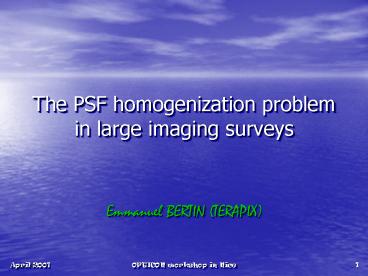The PSF homogenization problem in large imaging surveys - PowerPoint PPT Presentation
1 / 16
Title:
The PSF homogenization problem in large imaging surveys
Description:
An isotropic Gaussian/Moffat-like function with the FWHM of the median seeing is ... Moffat PSFs with FWHMs 0.6' and 0.9' (pixel size=0.18') April 2001. OPTICON ... – PowerPoint PPT presentation
Number of Views:96
Avg rating:3.0/5.0
Title: The PSF homogenization problem in large imaging surveys
1
The PSF homogenization problem in large imaging
surveys
- Emmanuel BERTIN (TERAPIX)
2
PSF Variations
- From exposure to exposure
- Seeing changes
- Defocusing, jittering, tracking errors
- Pupil rotation (alt-az telescopes)
- Within the field
- Optical aberrations
- Charge transfer problems on some CCDs
3
Co-adding images with different PSFs
- For most surveys, PSF variations are dominated by
the seeing - In the optical domain, almost unconstrained
seeing FWHM varies typically by 30 RMS (a factor
2 peak-to-peak). - This represents a factor 4 in peak intensity!!
- When constraints are set (queue scheduling), this
can be reduced to 10RMS. - The distribution of seeing FWHM has a positive
skewness
4
Seeing FWHM distributions in the optical (I band)
EIS-Wide (NTT)
VIRMOS (CFHT)
5
Seeing FWHM variations during the night
2MASS Jarrett et al. 2000
SDSS Yasuda et al. 2001
6
Co-adding images with different seeing
- In the case of fully overlapping images
- Non-linear combinations affect the photometry of
unresolved sources (e.g. Steidel Hamilton 1993) - The core of the PSF can no longer be approximated
by a Gaussian (German helmet). - May affect shear correction
- ?2 Image combination (Szalay et al. 1999) affected
7
Co-adding images with different seeing 2
- In the case of partial overlaps
- The PSF changes abruptly from place to place
- Need for a PSF-map
- Difficult to implement (cf. context-maps) !!
- Minimizing the number of image boundaries puts
strong constraints on the survey dithering
strategy - Gaps between CCDs almost unusable for scientific
use (unequal coverage, not enough stars to define
a PSF) - Less dithering yields astrometric and photometric
solutions which are less robust
8
Homogenizing the PSF?
- Make the PSF everywhere the same
- Technique similar to that of image subtraction
(Tomaney Crotts 1996, Alard Lupton 1998,
Alard 2000) - Convolution kernel with a restricted number of
degrees of freedom. - BUT no unique reference image available!
- One must define one. An isotropic
Gaussian/Moffat-like function with the FWHM of
the median seeing is a convenient choice
9
At which stage of the pipeline must the PSF be
homogenized?
- Image warping affects the PSF (and its
variability). - Re-projection to an equal-area grid corrects for
flux distorsions produced by flat-fielding - PSF homogenization (adaptive kernel filtering)
must be done AFTER image warping.
10
Effects of flat-fielding on flux sensitivity
11
Consequences of PSF homogenization the good
- PSF homogenization corrects for PSF anisotropy.
- PSF Homogenization removes the ambiguity of the
definition of a star centroid for asymmetric PSFs
- Astrometric calibration still needed, but it does
not need to be more accurate than, say, a
fraction of the stellar FWHM. - Fine tuning of astrometric centering is taken
care of by the variable PSF-correction. - PSF homogenization can include flux rescaling as
a free parameter. - Provides a relative photometric calibration that
can handle inhomogeneous sensitivity across the
field.
12
Consequences of PSF homogenization the bad
- PSF Homogenization is a linear and (locally)
shift-invariant process - Image artifacts will spread beyond the masked
areas - Prior interpolation of image defects might be
necessary - Objects that touch the frame boundaries must be
excluded - Correlation at the PSF scale will be introduced
in the noise. - Will one have to use correlation-maps for
optimum detection, or will the variations of the
noise correlation function be negligible in
reasonable cases? - The next generation of source extraction software
must be able to measure and make extensive use of
the (background) noise correlation function.
13
PSF homogenization as seen in Fourier space (1D)
Moffat PSFs with FWHMs 0.6 and 0.9 (pixel
size0.18)
14
PSF homogenization as seen in Fourier space (2D)
Example of a 2D kernel MTF to convert 0.9 FWHM
images to 0.75 FWHM
15
PSF-homogenization how does it look like?
Originally 0.6
Originally 0.9
16
Conclusion
- Awaits implementation in SWarp
- Major undertaking
- Speed issues
- Robustness in empty regions
- Astrometric fine-tuning issue
- Photometric anchors must be specified
- Adequacy for critical scientific analyses like
weak gravitational lensing measurements needs to
be assessed!































